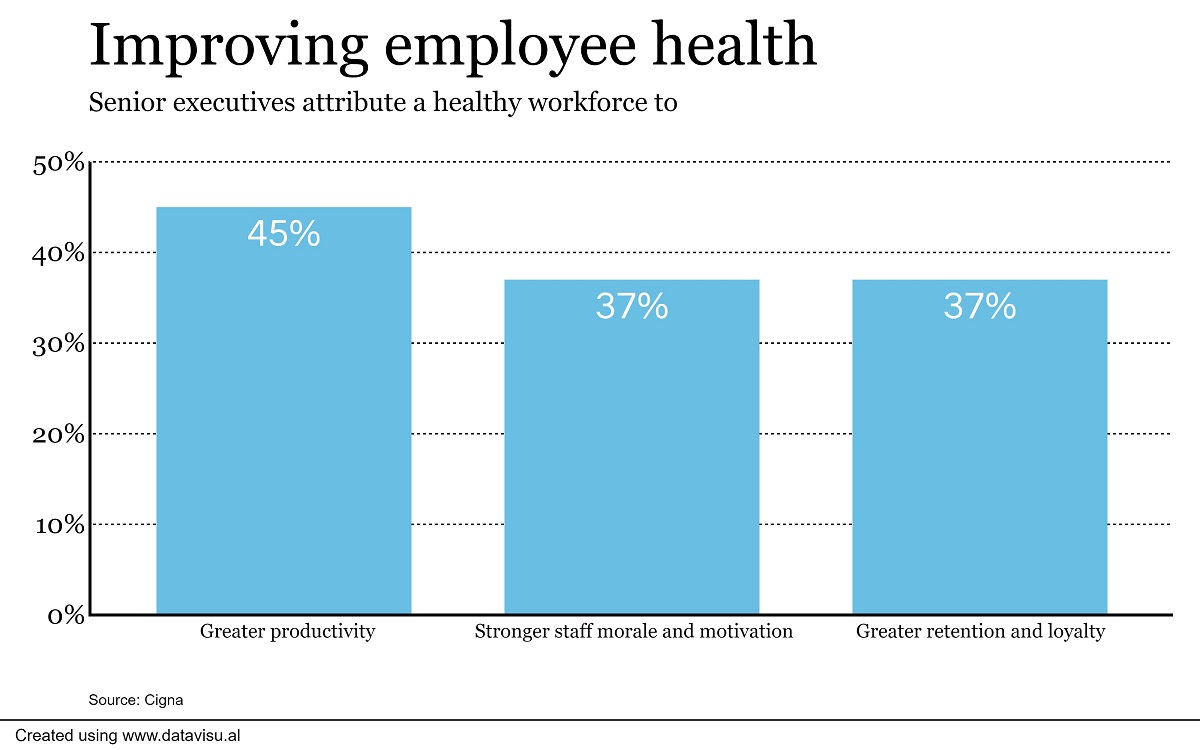The largest health crisis in modern history created a tipping point for every business. The global workforce is overwhelmed, over-worked and burnt out, and employers are challenged by unsustainable costs and complexity.
There’s no denying that health is more important than ever, but can it help your business grow? I’m convinced HR professionals can use today’s heightened importance on health and wellbeing as an opportunity to drive greater value for the businesses we serve. Your health plan can actually be a growth plan, bringing unmatched value to your organization and putting HR professionals in the driver’s seat of your company’s success.
Here’s how:
1. Prove to the C-Suite that healthy employees = healthy business.
As HR leaders, we can help executive leaders across the organizations understand the role that employee health plays in business performance. In fact, on average companies with high employee engagement are 23% more profitable, and those with high scores in corporate health and wellness self-assessments perform better than the overall S&P 500 Index.
 According to an Economist Intelligence report, commissioned by Cigna, senior executives attribute a healthy workforce to greater productivity (45%), stronger staff morale and motivation (37%), and greater retention and loyalty (37%). During today’s great resignation where nearly 4 million workers are changing jobs each month, investments that drive higher workforce morale, motivation, retention and loyalty cannot be ignored.
According to an Economist Intelligence report, commissioned by Cigna, senior executives attribute a healthy workforce to greater productivity (45%), stronger staff morale and motivation (37%), and greater retention and loyalty (37%). During today’s great resignation where nearly 4 million workers are changing jobs each month, investments that drive higher workforce morale, motivation, retention and loyalty cannot be ignored.
2. Sell-in your CFO.
Speak your chief financial officer’s language by proving the return on investment in health. Show how your health plan ensures financial health, helping to predict and manage financial risk for your company and employees while optimizing cash flow and improving profitability. Demonstrate solutions that address expensive health risks and provide cost protection, such as stop-loss insurance or other financial protections. Highlight specialty drug cost reductions for the plan and employees, and look for compelling clinical performance guarantees that hold the insurance company accountable for improving outcomes for the highest cost medical conditions. Show flexible and affordable, in-network pharmacies for employees and networks of high-performing provider relationships that deliver affordable and effective care, and that meet outcome standards.
It’s also important to your CFO how this health plan engages employees on an individual level. Show that guiding employees to the right care, at the right place, at the right time, improves productivity and health outcomes and can impact savings. This in turn lowers the cost of care for each employee—creating greater affordability and productivity for your business.
3. Choose the right key performance indicator.
You know a healthier workforce translates to higher productivity, better morale and greater employee retention. Now you have to prove it.
You’ve worked hard to nurture a healthy workforce culture by establishing and maintaining healthy practices for employees that reduce stress and burnout while boosting productivity, engagement and retention. Use employee surveys to get a pulse on morale, satisfaction, loyalty and engagement. Measure productivity in terms of absenteeism, presenteeism, and revenue per employee. Ask your insurance carrier to demonstrate performance of health outcomes.
If your workforce is truly healthier, you’ll see an improvement from baseline metrics. Beyond the basics, look for indicators of the resilience and vitality of your workforce to ensure they’re not just surviving—but thriving.
4. Select the right healthcare partner.
 If you haven’t traditionally focused on employee health and wellbeing, it can be hard to figure out where to start. Find a partner who will help build wellness plans to meet your company’s needs and the needs of your employees. Efforts that focus on improving the health and wellbeing of your workforce can translate to more productivity and better performance of your business. Critically, it can also make healthcare more affordable, predictable and simple for both your business and employees. Your health care partner can help your business prepare for the future by continuously innovating to address the health challenges of today and tomorrow.
If you haven’t traditionally focused on employee health and wellbeing, it can be hard to figure out where to start. Find a partner who will help build wellness plans to meet your company’s needs and the needs of your employees. Efforts that focus on improving the health and wellbeing of your workforce can translate to more productivity and better performance of your business. Critically, it can also make healthcare more affordable, predictable and simple for both your business and employees. Your health care partner can help your business prepare for the future by continuously innovating to address the health challenges of today and tomorrow.
Consider switching plans if your healthcare partner isn’t meeting this objective—because better health care for your employees should drive better business outcomes.
Switching plans may seem like a hassle, but if a new partner can turn your health plan into a growth plan—it’s worth the change. Plus, a good partner will make the integration and implementation of benefits simple and easy for your team, while ensuring employees have easy access to care from day one. They’ll also ease the burden of benefits communication, knowing that having employees who understand their benefits is critical to engagement.
HR executives have a tremendous opportunity to drive greater business value and growth through better employee health, well-being and engagement. Use the opportunity to establish a culture of health and generate vitality within your workforce to help your organization meet its objectives, and lean into your health partner for additional support. The healthiest businesses have the healthiest employees.
The post 4 steps to turn your health plan into a growth plan appeared first on HR Executive.